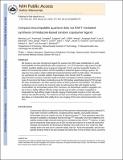| dc.contributor.author | Liu, Wenhao | |
| dc.contributor.author | Greytak, Thomas J. | |
| dc.contributor.author | Lee, Jungmin | |
| dc.contributor.author | Wong, Cliff | |
| dc.contributor.author | Park, Jongnam | |
| dc.contributor.author | Marshall, Lisa Faye | |
| dc.contributor.author | Jiang, Wen | |
| dc.contributor.author | Curtin, Peter N. | |
| dc.contributor.author | Ting, Alice Y. | |
| dc.contributor.author | Nocera, Daniel G. | |
| dc.contributor.author | Fukumura, Dai | |
| dc.contributor.author | Jain, Rakesh K. | |
| dc.contributor.author | Bawendi, Moungi G. | |
| dc.date.accessioned | 2012-10-05T15:14:01Z | |
| dc.date.available | 2012-10-05T15:14:01Z | |
| dc.date.issued | 2009-12 | |
| dc.date.submitted | 2009-09 | |
| dc.identifier.issn | 0002-7863 | |
| dc.identifier.issn | 1520-5126 | |
| dc.identifier.uri | http://hdl.handle.net/1721.1/73650 | |
| dc.description.abstract | We present a new class of polymeric ligands for quantum dot (QD) water solubilization to yield biocompatible and derivatizable QDs with compact size (10−12 nm diameter), high quantum yields (>50%), excellent stability across a large pH range (pH 5−10.5), and low nonspecific binding. To address the fundamental problem of thiol instability in traditional ligand exchange systems, the polymers here employ a stable multidentate imidazole binding motif to the QD surface. The polymers are synthesized via reversible addition−fragmentation chain transfer-mediated polymerization to produce molecular weight controlled monodisperse random copolymers from three types of monomers that feature imidazole groups for QD binding, polyethylene glycol (PEG) groups for water solubilization, and either primary amines or biotin groups for derivatization. The polymer architecture can be tuned by the monomer ratios to yield aqueous QDs with targeted surface functionalities. By incorporating amino-PEG monomers, we demonstrate covalent conjugation of a dye to form a highly efficient QD-dye energy transfer pair as well as covalent conjugation to streptavidin for high-affinity single molecule imaging of biotinylated receptors on live cells with minimal nonspecific binding. The small size and low serum binding of these polymer-coated QDs also allow us to demonstrate their utility for in vivo imaging of the tumor microenvironment in live mice. | en_US |
| dc.description.sponsorship | National Cancer Institute (U.S.) (Grant no. R01-CA126642) | en_US |
| dc.description.sponsorship | National Cancer Institute (U.S.) (Grant no. R01-CA085140) | en_US |
| dc.description.sponsorship | National Cancer Institute (U.S.) (Grant no. R01-CA115767) | en_US |
| dc.description.sponsorship | National Cancer Institute (U.S.) (Grant no. P01-CA080124) | en_US |
| dc.description.sponsorship | National Cancer Institute (U.S.) (Grant no. R01-CA096915) | en_US |
| dc.description.sponsorship | National Institutes of Health (U.S.) (MIT-Harvard NIH Center for Cancer Nanotechnology Excellence (1U54-CA119349)) | en_US |
| dc.description.sponsorship | Massachusetts Institute of Technology. Dept. of Chemistry Instrumentation Facility (CHE-980806) | en_US |
| dc.description.sponsorship | Massachusetts Institute of Technology. Dept. of Chemistry Instrumentation Facility (DBI-9729592) | en_US |
| dc.description.sponsorship | Massachusetts Institute of Technology. Institute for Soldier Nanotechnologies (W911NF-07-D-0004) | en_US |
| dc.description.sponsorship | National Science Foundation (U.S.). Materials Research Science and Engineering Centers (Program) (DMR-0117795) | en_US |
| dc.description.sponsorship | United States. Army Research Office (W911NF-06-1-0101) | en_US |
| dc.description.sponsorship | National Science Foundation (U.S.) (Graduate Research Fellowship) | en_US |
| dc.description.sponsorship | Life Sciences Research Foundation (Novartis Fellow) | en_US |
| dc.language.iso | en_US | |
| dc.publisher | American Chemical Society | en_US |
| dc.relation.isversionof | http://dx.doi.org/10.1021/ja908137d | en_US |
| dc.rights | Article is made available in accordance with the publisher's policy and may be subject to US copyright law. Please refer to the publisher's site for terms of use. | en_US |
| dc.source | PMC | en_US |
| dc.title | Compact biocompatible quantum dots via RAFT-mediated synthesis of imidazole-based random copolymer ligand | en_US |
| dc.type | Article | en_US |
| dc.identifier.citation | Liu, Wenhao et al. “Compact Biocompatible Quantum Dots via RAFT-Mediated Synthesis of Imidazole-Based Random Copolymer Ligand.” Journal of the American Chemical Society 132.2 (2010): 472–483. Web. | en_US |
| dc.contributor.department | Massachusetts Institute of Technology. Department of Chemistry | en_US |
| dc.contributor.department | Massachusetts Institute of Technology. Department of Physics | en_US |
| dc.contributor.approver | Bawendi, Moungi G. | |
| dc.contributor.mitauthor | Bawendi, Moungi G. | |
| dc.contributor.mitauthor | Liu, Wenhao | |
| dc.contributor.mitauthor | Greytak, Thomas J. | |
| dc.contributor.mitauthor | Lee, Jungmin | |
| dc.contributor.mitauthor | Wong, Cliff | |
| dc.contributor.mitauthor | Park, Jongnam | |
| dc.contributor.mitauthor | Marshall, Lisa Faye | |
| dc.contributor.mitauthor | Curtin, Peter N. | |
| dc.contributor.mitauthor | Ting, Alice Y. | |
| dc.contributor.mitauthor | Nocera, Daniel G. | |
| dc.relation.journal | Journal of the American Chemical Society | en_US |
| dc.eprint.version | Author's final manuscript | en_US |
| dc.type.uri | http://purl.org/eprint/type/JournalArticle | en_US |
| eprint.status | http://purl.org/eprint/status/PeerReviewed | en_US |
| dspace.orderedauthors | Liu, Wenhao; Greytak, Andrew B.; Lee, Jungmin; Wong, Cliff R.; Park, Jongnam; Marshall, Lisa F.; Jiang, Wen; Curtin, Peter N.; Ting, Alice Y.; Nocera, Daniel G.; Fukumura, Dai; Jain, Rakesh K.; Bawendi, Moungi G. | en |
| dc.identifier.orcid | https://orcid.org/0000-0003-2220-4365 | |
| dc.identifier.orcid | https://orcid.org/0000-0002-8277-5226 | |
| dc.identifier.orcid | https://orcid.org/0000-0002-4507-1115 | |
| dc.identifier.orcid | https://orcid.org/0000-0001-9769-2418 | |
| mit.license | PUBLISHER_POLICY | en_US |
| mit.metadata.status | Complete | |
